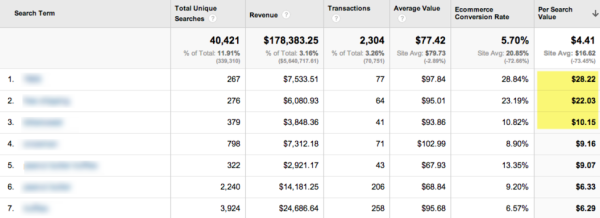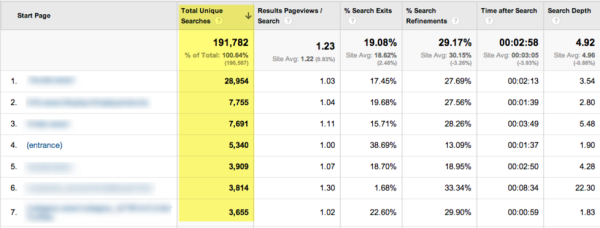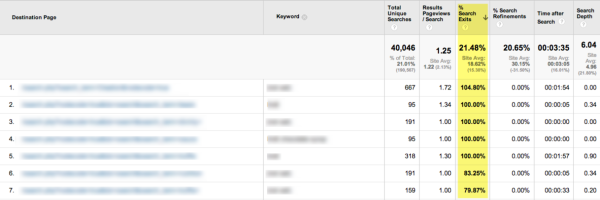Use Site Search Data To Fuel Your Content & Key Phrase Strategy
Blindfolded, Dave listened carefully to his guide. Her clues about what lay beyond the two doors were interesting, but vague. Then the horn blared. He was out of time! He had to choose his path. But how? He needed more information! Much like Dave, marketers are often in the dark when they make content strategy […]

Image via Shutterstock
Blindfolded, Dave listened carefully to his guide. Her clues about what lay beyond the two doors were interesting, but vague. Then the horn blared. He was out of time! He had to choose his path. But how? He needed more information!
Much like Dave, marketers are often in the dark when they make content strategy decisions. More often than not, they rely on data gleaned from out-of-the-box analytics (that only tells half the story).
But, you have better options! Why not fuel your content strategy with signals created by your own audience? Your site search data can help you do exactly that.
What is Site Search & How Can it Help Your Content Strategy?
Site search is an internal website function that enables users to search your site’s content. It can either be part of your CMS/infrastructure (most CMS systems come with their own search functionality), or a third-party solution, such as Google Site Search.
Customers often turn to site search when they are unable to locate what they need on your site. By entering a query in the search box – and subsequent refinements – they have a better chance of finding the information or products they want on your website.
Because customers use site search to tell you exactly what they are looking for, it can help you create an effective content strategy. How so? The search refinements performed within a website yield valuable insights that can be used to inform website content, paid key phrases, and SEO tactics. This data can also help you improve usability and conversions. Overall, your site search data can be a search marketing goldmine.
Think of site search this way: imagine that you have a brick and mortar business, and every day you stand at the door and ask each customer what they are there to buy. Then when they leave, you ask what they ended-up buying. And you write down all this information. Well, site search offers you just that. It will record what people are looking for, if they found it, and whether or not they ended-up buying it.
Where Site Search Data & Your Content Strategy Meet
Site search data contain a wealth of information that you can use to drive your content strategy. It’s just a matter of examining the data and seeing the opportunities. Below are a few key ways that site search data can help:
- Optimization: Site search reports contain highly relevant keywords since they reflect the exact terms your visitors entered into the search box. Use these internal search terms to improve your on-page and metadata optimization for higher rankings through organic search, or better performance in your paid campaigns. Tighter alignment with these search terms will also improve page and website retention since visitors will find more value on the pages.
- New Content Ideas: Your site search data can also point out possible deficiencies in your existing content. If your analysis reveals a lot of searches for content you do not have, consider building out these content themes. Doing so will help keep visitors engaged on site, and help capture new visitors and volume through search engine traffic. It also can shine light on some naming conventions. For instance, you might learn that consumers refer to a product in a completely different way than you do (e.g., Power Toothbrush vs. Electric Toothbrush).
- Refinement Opportunities: If your site search data shows a lot of searches for content themes you already cover, you might want to examine the long-tail terms to see if they are a detailed match. For example, you might have a lot of content around HD cameras, but the consumer is actually looking for HD video cameras. Because of that, you might rank, but not for the right content. Or, your home page might rank for the term, but the content resides on a deeper page, and the visitor has a hard time finding it.
- Market/Product Research: Site search data will show you how well your product is performing. For instance, your analysis might reveal thousands of site searches for toothpaste, but you have sold very little of it on your site. This type of trend indicates that you are either selling the wrong type of product or it is too expensive or irrelevant to the market/audience. Your data can also tell you what your consumers are interested in. In fact, it is not uncommon for entirely new product lines to be created based on consumer insights. For example, if thousands of people are searching for strawberry toothpaste every day, you might want to let R&D know.
Site Search Data In Action
Let’s assume you’ve installed a form of internal site search, and you are tracking your searches and their behavior and activity. Now what? How can you make use of the data? In the following examples, I will highlight some of the ways we leveraged site search data to influence e-commerce, on-site optimization, search, and content:
1. E-Commerce: One of my e-commerce clients is tracking sales and site searches in Google Analytics. Doing so has proven very interesting because it reveals a per-search value — the revenue driven through the results sets from searches by a term.
We then sorted this list by the highest per-search value.
That gave us the top revenue-driving internal search terms. When we compared them to our paid strategy, we had a 62% overlap. So, we created a new ad group, added all these terms, and used the internal search result pages as landing pages. This dramatically increased our conversion rate and overall sales from paid search:
2. Relevance/On-Page Elements: One of the first steps to take when you start to review your site search data is to analyze the pages that triggered an internal search, as shown below for one of our Lifestyle brands:
This analysis pinpointed the pages where the user was “lost” and initiated their query. It is also important to determine where the user abandoned his/her search. This can be found by examining the destination page report with the search term, and sorting by the highest exit rate (%Search Exits is the percentage of searches that resulted in an immediate exit from your site.).
These results tell the complete story, from where the consumer started the search, what he searched for, where he landed, and where he was when he left. Now, it’s the marketer’s job to review these pages to determine if the user should have landed there with the given term; and if it’s relevant, ask the following: “Why did he leave?” “Was the intent different?” and “Do we need to modify the calls to action?”
3. Optimizing For Organic & Paid Search: In this example, the brand had a solid key phrase strategy, the pages were optimized correctly, and overall, it dominated the SERPs for its terms. So, where could it go next?
By examining its site search terms, we discovered about 200 new phrases that were not part of its existing key phrase strategy. We sorted these newly discovered terms by engagement and performance. This gave us a great list of highly performing terms with existing landing pages (the actual results page).

Newly-discovered KPs are marked in green.
Again, the beauty here is that you get the best performing combinations (keyword [intent] to landing page); this is essentially an organic and paid strategy wrapped in a box. We then created customized pages for those newly discovered terms that are highly optimized for SEO, and started to rank very well within a short period of time. This resulted in greater organic reach and improved paid ROI.
4. Content: How can site search data inform your content themes and ideas? In the below example, we looked at the search depth value (the average number of pages visitors viewed after getting results for the search term). This data shows you what the user was unable to find, and therefore continued to browse.
We then took these key phrases and worked with the brand and its planning agency to create content assets around those terms. Again, a lot of the terms were closely related to existing content, even just synonyms, like the earlier-mentioned “Power Toothbrush vs. Electric Toothbrush.” By using these newly discovered and highly performing terms inside your content, you can provide more value to your current audience (because now, they can find what they are looking for), and you can create greater reach (higher rankings) for those terms you were unaware of before.
Don’t Operate In The Dark — Use Site Search Data To Discover Important Insights
Today, it is critical to have an effective content strategy. Fortunately, site search data can help inform your content strategy along several important metrics: search frequency, visitor intent, keyword/key phrase relevance, visitor satisfaction, navigation effectiveness, and conversions. When developing your content strategy, don’t operate in the dark. Instead, tap into your site search data to shed light on important insights that could translate into a competitive advantage.
If you have been leveraging your site search data, I’d like to hear about your success. How has your search site data informed your content strategy thus far?
Opinions expressed in this article are those of the guest author and not necessarily Search Engine Land. Staff authors are listed here.
Related stories






